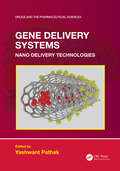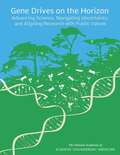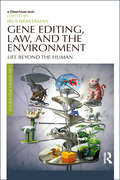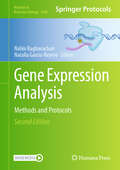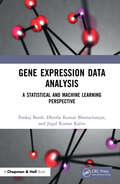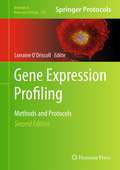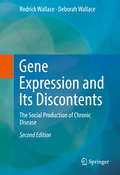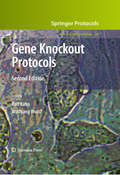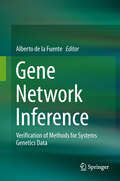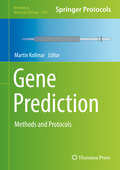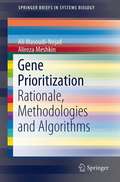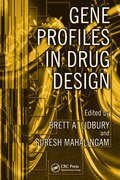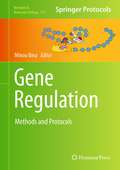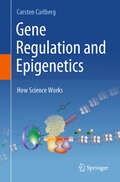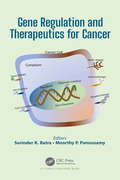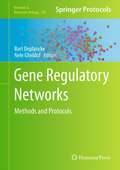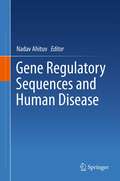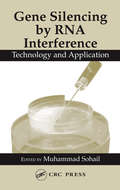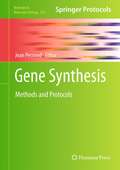- Table View
- List View
Gene Delivery: Nanotechnology and Therapeutic Applications (Drugs and the Pharmaceutical Sciences)
by Yashwant PathakGene delivery is a transport of genes of therapeutic values into the chromosomes of the cells or tissues which can be targeted to replace the faulty genes. In last two decades lot of research efforts are dedicated to gene delivery for therapeutic applications. Today gene therapy is promising approach in treatment of genetic diseases including mitochondrial related diseases like blindness, muscular dystrophy, cystic fibrosis, and some cancers. Gene Delivery Systems: Nano Delivery Technologies observes the exploration of nanotechnology for gene therapy and gene delivery. Written by prominent authors in the field, this book covers various aspects of gene delivery including challenges in delivering gene therapy, advances in genome editing, RNA-based gene therapy, Green nanoparticles for oligonucleotide delivery. Additional features include" Provides the most up to date information on the development of gene therapy, from the technology involved to gene correction and genome editing. Includes knowledge of the current application of CRISPR/Cas9 gene-editing technique; an approach that has recently been given the Noble Prize. Examines the development of mRNA vaccines for Covid -19 in challenging pandemic scenario Discusses siRNA, mRNA, and DNA plasmids.
Gene Drives On The Horizon: Advancing Science, Navigating Uncertainty, And Aligning Research With Public Values
by Committee on Gene Drive Research in Non-Human Organisms Recommendations for Responsible ConductResearch on gene drive systems is rapidly advancing. Many proposed applications of gene drive research aim to solve environmental and public health challenges, including the reduction of poverty and the burden of vector-borne diseases, such as malaria and dengue, which disproportionately impact low and middle income countries. However, due to their intrinsic qualities of rapid spread and irreversibility, gene drive systems raise many questions with respect to their safety relative to public and environmental health. Because gene drive systems are designed to alter the environments we share in ways that will be hard to anticipate and impossible to completely roll back, questions about the ethics surrounding use of this research are complex and will require very careful exploration. Gene Drives on the Horizon outlines the state of knowledge relative to the science, ethics, public engagement, and risk assessment as they pertain to research directions of gene drive systems and governance of the research process. This report offers principles for responsible practices of gene drive research and related applications for use by investigators, their institutions, the research funders, and regulators.
Gene Drives at Tipping Points: Precautionary Technology Assessment and Governance of New Approaches to Genetically Modify Animal and Plant Populations
by Arnim Von Gleich Winfried SchröderThis open access book reports on a pilot project aiming at collecting information on the socio-ecological risks that could arise in the event of an uncontrolled spread of genetically engineered organisms into the environment. The researchers will, for instance, be taking a closer look at genetically engineered oilseed rape, genetically engineered olive flies as well as plants and animals with so-called gene drives. The book mainly adresses researchers.
Gene Drives on the Horizon: Advancing Science, Navigating Uncertainty, and Aligning Research with Public Values
by Engineering Medicine National Academies of SciencesResearch on gene drive systems is rapidly advancing. Many proposed applications of gene drive research aim to solve environmental and public health challenges, including the reduction of poverty and the burden of vector-borne diseases, such as malaria and dengue, which disproportionately impact low and middle income countries. However, due to their intrinsic qualities of rapid spread and irreversibility, gene drive systems raise many questions with respect to their safety relative to public and environmental health. Because gene drive systems are designed to alter the environments we share in ways that will be hard to anticipate and impossible to completely roll back, questions about the ethics surrounding use of this research are complex and will require very careful exploration. Gene Drives on the Horizon outlines the state of knowledge relative to the science, ethics, public engagement, and risk assessment as they pertain to research directions of gene drive systems and governance of the research process. This report offers principles for responsible practices of gene drive research and related applications for use by investigators, their institutions, the research funders, and regulators.
Gene Editing, Law, and the Environment: Life Beyond the Human (Law, Science and Society)
by Irus BravermanTechnologies like CRISPR and gene drives are ushering in a new era of genetic engineering, wherein the technical means to modify DNA are cheaper, faster, more accurate, more widely accessible, and with more far-reaching effects than ever before. These cutting-edge technologies raise legal, ethical, cultural, and ecological questions that are so broad and consequential for both human and other-than-human life that they can be difficult to grasp. What is clear, however, is that the power to directly alter not just a singular form of life but also the genetics of entire species and thus the composition of ecosystems is currently both inadequately regulated and undertheorized. In Gene Editing, Law, and the Environment, distinguished scholars from law, the life sciences, philosophy, environmental studies, science and technology studies, animal health, and religious studies examine what is at stake with these new biotechnologies for life and law, both human and beyond.
Gene Expression Analysis: Methods and Protocols (Methods in Molecular Biology #2880)
by Nalini Raghavachari Natalia Garcia-ReyeroThis second edition volume expands on the previous edition with updates on the latest methodologies in the transcriptomics field. The chapters in this book cover topics such as spatial omics, long-read sequencing technology, tissue microarrays, analysis of saliva and extracellular vesicles, machine learning and artificial intelligence-based approaches for analysis of singe cells transcriptome, and large sets of data on multi-omics including transcriptomics. Written in the highly successful Methods in Molecular Biology series format, chapters include introductions to their respective topics, lists of the necessary materials and reagents, step-by-step, readily reproducible laboratory protocols, and tips on troubleshooting and avoiding known pitfalls. Cutting-edge and practical, Gene Expression Analysis: Methods and Protocols, Second Edition is a valuable resource for advanced undergraduate and graduate students studying gene expression analysis, and scientists interested in learning more about this rapidly advancing field.
Gene Expression Data Analysis: A Statistical and Machine Learning Perspective
by Dhruba Kumar Bhattacharyya Jugal Kumar Kalita Pankaj BarahDevelopment of high-throughput technologies in molecular biology during the last two decades has contributed to the production of tremendous amounts of data. Microarray and RNA sequencing are two such widely used high-throughput technologies for simultaneously monitoring the expression patterns of thousands of genes. Data produced from such experiments are voluminous (both in dimensionality and numbers of instances) and evolving in nature. Analysis of huge amounts of data toward the identification of interesting patterns that are relevant for a given biological question requires high-performance computational infrastructure as well as efficient machine learning algorithms. Cross-communication of ideas between biologists and computer scientists remains a big challenge. Gene Expression Data Analysis: A Statistical and Machine Learning Perspective has been written with a multidisciplinary audience in mind. The book discusses gene expression data analysis from molecular biology, machine learning, and statistical perspectives. Readers will be able to acquire both theoretical and practical knowledge of methods for identifying novel patterns of high biological significance. To measure the effectiveness of such algorithms, we discuss statistical and biological performance metrics that can be used in real life or in a simulated environment. This book discusses a large number of benchmark algorithms, tools, systems, and repositories that are commonly used in analyzing gene expression data and validating results. This book will benefit students, researchers, and practitioners in biology, medicine, and computer science by enabling them to acquire in-depth knowledge in statistical and machine-learning-based methods for analyzing gene expression data. Key Features: An introduction to the Central Dogma of molecular biology and information flow in biological systems A systematic overview of the methods for generating gene expression data Background knowledge on statistical modeling and machine learning techniques Detailed methodology of analyzing gene expression data with an example case study Clustering methods for finding co-expression patterns from microarray, bulkRNA, and scRNA data A large number of practical tools, systems, and repositories that are useful for computational biologists to create, analyze, and validate biologically relevant gene expression patterns Suitable for multidisciplinary researchers and practitioners in computer science and biological sciences
Gene Expression Profiling
by Lorraine O'DriscollUnderstanding gene expression and how it changes under normal and pathological conditions is essential to our understanding of the fundamentals of cell biology through to the targeted treatment of disease. In Gene Expression Profiling: Methods and Protocols, Second Edition, experts in their particular fields compile detailed protocols for a broad range of techniques, currently available and being further developed, for the analysis of gene expression at the DNA, RNA, and protein levels. Written in the highly successful Methods in Molecular BiologyTM series format, chapters include introductions to their respective topics, lists of the necessary materials and reagents, step-by-step, readily reproducible laboratory protocols, and tips on troubleshooting and avoiding known pitfalls. Practical and easy-to-use, Gene Expression Profiling: Methods and Protocols, Second Edition presents a collection of clearly described and illustrated chapters, certain to be helpful to researchers in academia, in hospitals, and in industry who are interested in applying techniques, whether basic or advanced, for the analysis of gene expression.
Gene Expression and Its Discontents
by Rodrick Wallace Deborah WallaceThis book describes how epigenetic context, in a large sense, affects gene expression and the development of an organism, using the asymptotic limit theorems of information theory to construct statistical models useful in data analysis. The approach allows deep understanding of how embedding context affects development. We find that epigenetic information sources act as tunable catalysts, directing ontogeny into characteristic pathways, a perspective having important implications for epigenetic epidemiology. In sum, environmental stressors can induce a broad spectrum of developmental dysfunctions, and the book explores a number of pandemic chronic diseases, using U. S. data at different scales and levels of organization. In particular, we find the legacy of slavery has been grossly compounded by accelerating industrial decline and urban decay. Individual chapters are dedicated to obesity and its sequelae, coronary heart disease, cancer, mental disorders, autoimmune dysfunction, Alzheimer's disease, and other conditions. Developmental disorders are driven by environmental factors channeled by historical trajectory and are unlikely to respond to medical interventions at the population level in the face of persistent individual and community stress. Drugs powerful enough to affect deleterious epigenetic programming will likely have side effects leading to shortened lifespan. Addressing chronic conditions and developmental disorders requires significant large-scale changes in public policy and resource allocation.
Gene Function Analysis
by Michael F. OchsWith the advent of high-throughput technologies following completion of the human genome project and similar projects, the number of genes of interest has expanded and the traditional methods for gene function analysis cannot achieve the throughput necessary for large-scale exploration. This book brings together a number of recently developed techniques for looking at gene function, including computational, biochemical and biological methods and protocols.
Gene Jockeys: Life Science and the Rise of Biotech Enterprise
by Nicolas RasmussenThe scientific scramble to discover the first generation of drugs created through genetic engineering.The biotech arena emerged in the 1970s and 1980s, when molecular biology, one of the fastest-moving areas of basic science in the twentieth century, met the business world. Gene Jockeys is a detailed study of the biotech projects that led to five of the first ten recombinant DNA drugs to be approved for medical use in the United States: human insulin, human growth hormone, alpha interferon, erythropoietin, and tissue plasminogen activator.Drawing on corporate documents obtained from patent litigation, as well as interviews with the ambitious biologists who called themselves gene jockeys, historian Nicolas Rasmussen chronicles the remarkable, and often secretive, work of the scientists who built a new domain between academia and the drug industry in the pursuit of intellectual rewards and big payouts. In contrast to some who critique the rise of biotechnology, Rasmussen contends that biotech was not a swindle, even if the public did pay a very high price for the development of what began as public scientific resources. Within the biotech enterprise, the work of corporate scientists went well beyond what biologists had already accomplished within universities, and it accelerated the medical use of the new drugs by several years.In his technically detailed and readable narrative, Rasmussen focuses on the visible and often heavy hands that construct and maintain the markets in public goods like science. He looks closely at how science follows money, and vice versa, as researchers respond to the pressures and potential rewards of commercially viable innovations. In biotechnology, many of those engaged in crafting markets for genetically engineered drugs were biologists themselves who were in fact trying to do science.This book captures that heady, fleeting moment when a biologist could expect to do great science through the private sector and be rewarded with both wealth and scientific acclaim.
Gene Knockout Protocols
by Martin J. Tymms Ismail KolaHighly skilled investigators with extensive experience in gene targeting and mouse genetics describe their best techniques for the design of targeting constructs and for the analysis of the mouse phenotype. These include embryo transplantation, in vitro embryonic stem cell differentiation, creation of aggregation chimeras, mouse pathology, embryo cryopreservation, and transplantation. State-of-the-art and highly practical, Gene Knockout Protocols not only constitutes an invaluable source of readily reproducible techniques for those just entering the field of gene targeting, but also a key reference for all genetic researchers today.
Gene Knockout Protocols
by Ralf Kühn Wolfgang WurstWith the completion of the mouse and human genome sequences, the functional characterization of every mammalian gene and the deciphering of their molecular interaction network has become the next major challenge, and the mouse genome provides a convenient and vital model for these studies. In "Gene Knockout Protocols, Second Edition", distinguished contributors with extensive experience in the gene targeting and mouse genetics fields reveal a comprehensive collection of step-by-step laboratory protocols. Emphasizing the many new mutagenesis techniques developed over the last seven years, the volume covers topics such as gene modification in ES cells, stem cell manipulation, the generation of genetically engineered mice, and mutant phenotype analysis. Written in the highly successful Methods in Molecular BiologyTM series format, chapters contain brief introductions to their respective subjects, lists of the necessary materials and reagents, readily reproducible protocols, and notes on troubleshooting and avoiding known pitfalls. Fully updated and authoritative, "Gene Knockout Protocols, Second Edition" provides a unique collection of expert bench protocols certain to be a valuable resource for those just entering the field of gene targeting but also for all genetic researchers today.
Gene Machine: The Race to Decipher the Secrets of the Ribosome
by Venki RamakrishnanFrom Nobel Prize winner Venki Ramakrishnan &‘Beyond superb&’ Bill Bryson &‘A wonderful book&’ Ian McEwan Everyone knows about DNA, the essence of our being, the molecule where our genes reside. But DNA by itself is useless without a machine to decode the genetic information it contains. The ribosome is that machine. Venki Ramakrishnan tells the story of the race to uncover its enormously complex structure, a fundamental breakthrough that resolves an ancient mystery of life itself.
Gene Network Inference
by Alberto FuenteThis book presents recent methods for Systems Genetics (SG) data analysis, applying them to a suite of simulated SG benchmark datasets. Each of the chapter authors received the same datasets to evaluate the performance of their method to better understand which algorithms are most useful for obtaining reliable models from SG datasets. The knowledge gained from this benchmarking study will ultimately allow these algorithms to be used with confidence for SG studies e. g. of complex human diseases or food crop improvement. The book is primarily intended for researchers with a background in the life sciences, not for computer scientists or statisticians.
Gene Prediction: Methods and Protocols (Methods in Molecular Biology #1962)
by Martin KollmarThis volume introduces software used for gene prediction with focus on eukaryotic genomes. The chapters in this book describe software and web server usage as applied in common use-cases, and explain ways to simplify re-annotation of long available genome assemblies. Written in the highly successful Methods in Molecular Biology series format, chapters include introductions to their respective topics, lists of the necessary computational requirements, step-by-step, readily reproducible computational protocols, and tips on troubleshooting and avoiding known pitfalls.Cutting-edge and thorough, Gene Prediction: Methods and Protocols is a valuable resource for researchers and research groups working on the assembly and annotation of single species or small groups of species. Chapter 3 is available open access under a CC BY 4.0 license via link.springer.com.
Gene Prioritization
by Ali Masoudi-Nejad Alireza MeshkinIdentifying causal genes underlying susceptibility to human disease is a problem of primary importance in the post-genomic era and in current biomedical research. Recently, there has been a paradigm shift of such gene-discovery efforts from rare, monogenic conditions to common "oligogenic" or "multifactorial" conditions such as asthma, diabetes, cancers and neurological disorders. These conditions are referred to as multifactorial because, susceptibility to these diseases is attributed to the combinatorial effects of genetic variation at a number of different genes and their interaction with relevant environmental exposures. The goal of this book is to introduce gene prioritization aspects and the candidate gene prioritization algorithms to give readers a comprehensive view on the subject.
Gene Profiles in Drug Design
by Brett A. Lidbury Suresh MahalingamWith the successful mapping of the human genome, we have entered an age of unprecedented opportunity in which researchers are beginning to apply this vast repository of knowledge to the treatment of human disease. Gene-profiling technologies and the concept of individualized medicine are leading to the development of drugs with enhanced specificity
Gene Regulation
by Minou BinaThis volume offers cutting-edge technologies for studies of gene regulation. The chapters include introductions to their respective topics, lists of the necessary materials and reagents, and step-by-step, readily reproducible laboratory protocols.
Gene Regulation and Epigenetics: How Science Works
by Carsten CarlbergThis book delves into the fascinating realm of eukaryotic gene regulation. The specific expression of genes shapes the phenotype of cells and tissues. The regulation of gene expression, including up- and downregulation, is a fundamental aspect of nearly all physiological processes, both in health and disease. These dynamic processes respond to various daily challenges, such as dietary changes and infections. Therefore, it is crucial for not only biologists and biochemists but also all students in biomedical disciplines to understand gene regulation concepts. This foundational knowledge will benefit them in their specialized fields. A comprehensive understanding of transcription factors and the mechanisms that alter their activity is a fundamental goal of modern life science research. Epigenetics refers to the packaging and accessibility of the genome in each of the trillions of cells in our bodies. The prefix “epi” (meaning “upon,” “above,” or “beyond”) indicates that epigenetic processes do not alter the DNA sequence of our genome, adding a layer of information beyond that encoded in our genome. Genomic DNA is wrapped around complexes of histone proteins, helping it fit into a cell nucleus with a diameter of less than 10 μm. This protein-DNA complex is known as chromatin. The content of this book is linked to the “Molecular Medicine and Genetics” course, which the author has lectured on in various forms since 2002 at the University of Eastern Finland in Kuopio. This book is an updated version of the textbooks “Mechanisms of Gene Regulation” and “Human Epigenomics.” It is divided into 16 chapters. Following two introductory chapters, four chapters explore gene regulation from the perspective of transcription factors, while another four chapters focus on chromatin and non-coding RNA. Three chapters then discuss the impact of epigenetics from a health perspective, and the final three chapters address epigenetics from the perspective of diseases. A glossary in the appendix explains the major specialist terms.
Gene Regulation and Therapeutics for Cancer
by Surinder K. BatraDifferential gene regulation and targeted therapy are the critical aspects of several cancers. This book covers specific gene regulation and targeted therapies in different malignancies. It offers a comprehensive assessment of the transcriptional dysregulation in cancer, and considers some examples of transcriptional regulators as definitive oncogenic drivers in solid tumors, followed by a brief discussion of transcriptional effectors of the programs they drive, and discusses its specific targets. Most targeted therapeutics developed to date have been directed against a limited set of oncogenic drivers, exemplified by those encoding cell surface or cytoplasmic kinases that function in intracellular signaling cascades.
Gene Regulatory Networks
by Nele Gheldof Bart DeplanckeGene regulatory networks play a vital role in organismal development and function by controlling gene expression. With the availability of complete genome sequences, several novel experimental and computational approaches have recently been developed which promise to significantly enhance our ability to comprehensively characterize these regulatory networks by enabling the identification of respectively their genomic or regulatory state components, or the interactions between these two in unprecedented detail. Divided into five convenient sections, Gene Regulatory Networks: Methods and Protocols details how each of these approaches contributes to a more thorough understanding of the composition and function of gene regulatory networks, while providing a comprehensive protocol on how to implement them in the laboratory. Written in the highly successful Methods in Molecular BiologyTM series format, chapters contain introductions to their respective topics, lists of the necessary materials and reagents, step-by-step, readily reproducible laboratory protocols, and notes on troubleshooting and avoiding known pitfalls. Authoritative and accessible, Gene Regulatory Networks: Methods and Protocols aims to provide novices and experienced researchers alike with a comprehensive and timely toolkit to study gene regulatory networks from the point of data generation to processing, visualization, and modeling.
Gene Regulatory Sequences and Human Disease
by Nadav AhituvIn Gene Regulatory Sequences and Human Disease, the Editor will introduce the different technological advances that led to this breakthrough. In addition, several examples will be provided of nucleotide variants in noncoding sequences that have been shown to be associated with various human diseases.
Gene Silencing by RNA Interference: Technology and Application
by Muhammad SohailMaximizing the potential of RNA interference in functional genomics - as well as in the development of therapeutics - continues to be at the forefront of biomedical research. Unlike journal articles, Gene Silencing by RNA Interference: Technology and Application combines essential background to the RNAi field with practical techniques designed by r
Gene Synthesis
by Jean PeccoudThe de novo fabrication of custom DNA molecules is a transformative technology that significantly affects the biotechnology industry. Basic genetic engineering techniques for manipulating DNA in vitro opened an incredible field of opportunity in the life sciences. In, Gene Synthesis: Methods and Protocols expert researchers in the field detail many of the methods which are now commonly used to fabricate DNA . These include methods and techniques for the assembly of oligonucleotide, cloning of synthons into larger fragments, protocols and software applications, and educational and biosecurity impacts of gene synthesis. Written in the highly successful Methods in Molecular BiologyTM series format, the chapters include the kind of detailed description and implementation advice that is crucial for getting optimal results in the laboratory. Thorough and intuitive, Gene Synthese: Methods and Protocols aids scientists in understanding all the different stages of a complex gene synthesis process, while refining their understanding of gene synthesis and determine what part of the process they can or should do in their laboratory and what parts should be contracted to a specialized service provider.
